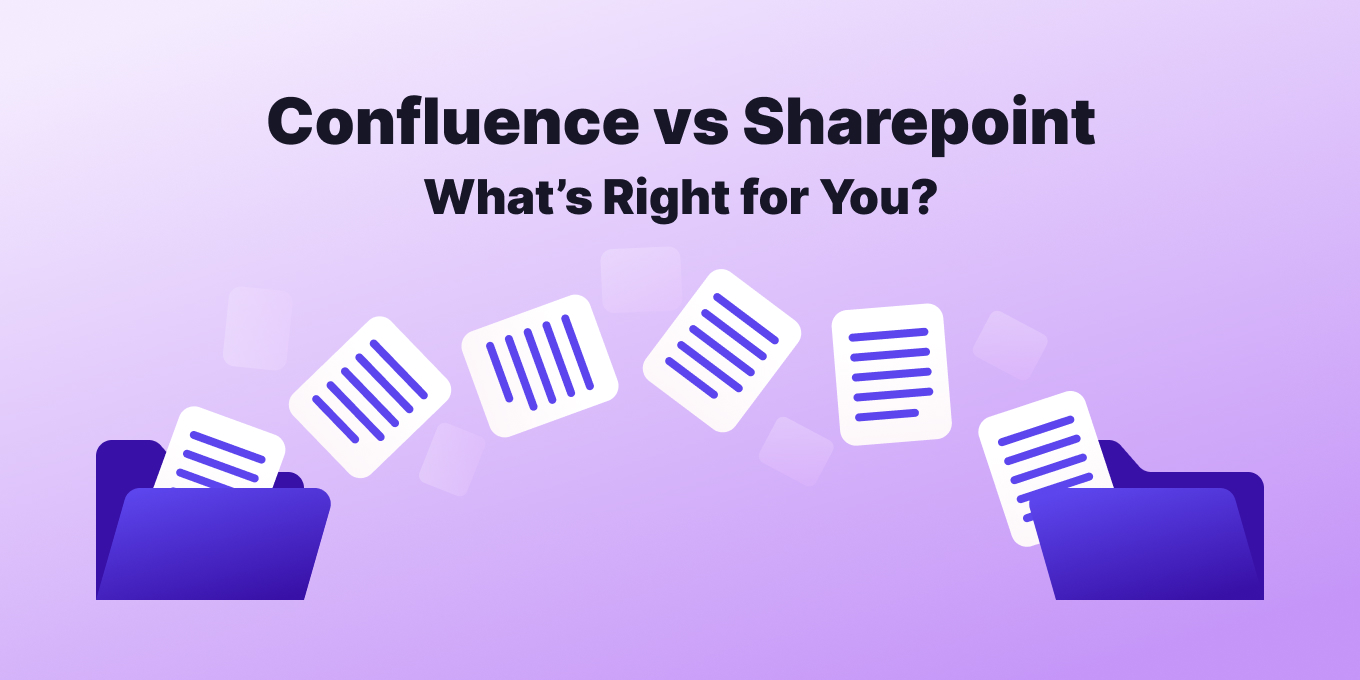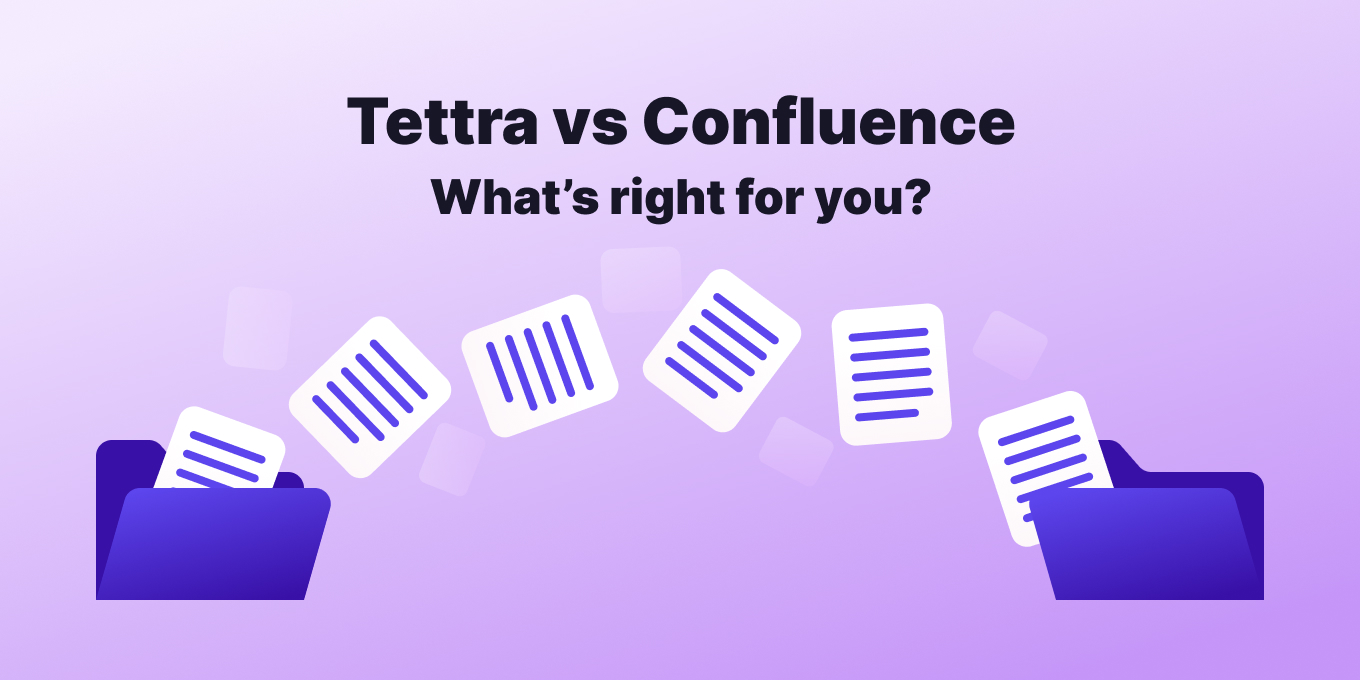Confluence is a versatile tool designed for team collaboration, documentation, and knowledge management across various organizational functions and industries.
But you already know that, because you’re looking for an alternative to Confluence.
And whether it’s due to features or budget, you may need an alternative knowledge management software to Confluence.
Take this Confluence review for example:
“…if you have ever built a website before it is extremely frustrating to use some of the limited or half functions that never do quite what you want or require too much fiddling to do something simple…”
If you’ve ever felt the same way about Confluence, it’s time for another knowledge base software.
What are the recommended alternatives to Confluence for knowledge management?
1. Tettra
Want simple?
Tettra is a top Confluence alternative because of a user-friendly knowledge management tool that integrates easily with Slack and Google Drive. You can ask questions of your docs and get immediate AI summaries and answers, based on your company info.
Tettra simplifies the management of company knowledge, making it accessible and manageable from within these communication tools, and enhancing your team’s workflow efficiency.
My colleagues and I appreciate Tettra for its ease of use and integration with Slack and Google. The functions and layout are not complicated, allowing all team members to familiarize themselves with Tettra pretty rapidly. This is a huge plus since we use Tetta on a daily basis and have lots of information to store.
G2 5-Star Review
Key Features:
- Q&A Workflow: This feature captures questions directly from team members and facilitates the creation of a feedback loop, allowing for continuous improvement of the knowledge base
- Content Verification: Ensures the accuracy and timeliness of the information in the knowledge base. Designated “knowledge experts” can verify and update content, maintaining the reliability of the knowledge shared within the organization
- AI Integration: Tettra’s integration with AI, specifically through Kai, enhances the user experience by providing instant answers from the knowledge base and identifying the right team members to address unresolved queries.
Tettra is perfect for small to medium-sized teams and customer service teams that require a straightforward, integrated solution for managing their internal knowledge.
Its ease of use and robust integration capabilities make it an ideal choice for teams that prioritize efficient communication and quick access to shared knowledge.
⭐️ Did you know? Tettra has a 4.6 G2 score compared to 4.1 for Confluence
2. Microsoft SharePoint
Here’s our 2nd recommended Confluence alternative, Microsoft SharePoint. It enhances team collaboration by integrating with Microsoft Office, making it an ideal tool for document management within familiar workflows.
- Best for: Existing Microsoft product users
- Features: Integrates well with other Microsoft products, offers collaborative whiteboards through a separate app, and supports page versioning.
- Starting Price: $5/user/month
⭐️ Take a look: Best Sharepoint Alternatives for 2024
3. Notion
The third best Confluence alternative is Notion. Notion is perfect for teams that value customization and ease of use, providing a simple, user-friendly digital workplace to manage your team’s knowledge and projects effectively.
- Best for: Teams seeking a highly customizable workspace
- Features: User-friendly interface, flexible document management, supports tasks, databases, and embedded apps within documents.
- Starting Price: Free for personal use; team plans start at $8/user/month
⭐️ Recommended:
4. Google Workspace
The fourth best Confluence alternative? Google Workspace is the ultimate collaboration tool for teams that rely on Google services, offering extensive features for project collaboration and internal communication.
- Best for: Teams deeply integrated into Google’s ecosystem
- Features: Seamless integration with Google apps like Docs, Sheets, and Google Meet; real-time collaboration and editing.
- Starting Price: Business Starter plan at $6/user/month
5. Nuclino
And coming in at number 5 for best Confluence alternative is Nuclino.
Nuclino offers a straightforward and visually appealing platform for team collaboration and content management, acting as an efficient project management tool.
- Best for: Teams that value a clean, intuitive interface
- Features: Real-time collaborative editing, visual data organization using a mind map, and lightweight intranet functionalities.
- Starting Price: Free for the basic plan; Standard plan is $5/user/month
6. Zoho Connect
Zoho Connect, sometimes known as Zoho Wiki for its extensive knowledge management capabilities, brings a comprehensive suite of tools that facilitate not just collaboration but also project tracking and social networking.
- Best for: Organizations needing extensive collaboration tools beyond document management
- Features: Project management tools, social intranet features like forums and town halls, and integration across the Zoho suite.
- Starting Price: Free for up to 5 users; paid plans start at $3/user/month
7. ClickUp
With its versatile tools, ClickUp is ideal for teams looking for a dynamic workspace that adapts to their evolving needs, from task management to file sharing.
- Best for: Teams requiring a combination of project management and documentation
- Features: Project management, document collaboration, task assignments, and email within a single platform.
- Starting Price: Free for basic use; paid plans start at $5/user/month
8. Helpjuice
Helpjuice is the tool of choice for companies that require a knowledge base that fits seamlessly with their brand identity, coupled with outstanding customer support.
- Best for: Organizations looking for a customizable knowledge base
- Features: Highly customizable interface, supports extensive branding and theming, includes robust content creation tools.
- Starting Price: Starts at $120/month for up to 4 users
9. Slab
Slab stands out with its emphasis on searchability and ease of use, making it an excellent tool for knowledge sharing and content policy management.
- Best for: Teams prioritizing simplicity and powerful search in knowledge management
- Features: User-friendly content organization, strong search capabilities, and integration with popular tools like Slack and GitHub.
- Starting Price: $8/user/month
10. Guru
Guru Guru is a dynamic knowledge management software that enhances team productivity by making information accessible and easy to update in real-time.
- Best for: Teams seeking a seamless integration with their daily workflows
- Features: AI-powered suggestions for content relevance, robust browser extension and Slack integration, real-time verification of information accuracy.
- Starting Price: Free to $15 per month
11. Wiki.js
Wiki.js appeals to tech-savvy teams who want the freedom to customize and extend their knowledge management tools, making it a great Confluence alternative and an excellent choice for those requiring a flexible, open-source project management tool.
- Best for: Developer-focused teams looking for an open-source solution
- Features: Supports various authentication methods, integrates with modern development workflows, and customizable through plugins.
- Starting Price: Free (open-source)
Why Look for Confluence Alternatives?
- User Interface and Usability: Confluence’s interface can be complex and overwhelming for new users. Navigating through spaces, pages, and the myriad of features can sometimes be confusing, which can lead to a steep learning curve.
- See “Why have you made Confluence so complicated?” on the Atlassian Confluence forum.
- Search Functionality: Users often report that Confluence’s search functionality can be less intuitive or effective than expected. Finding specific information quickly can be challenging, especially in large spaces with extensive content.
- See “Why is Confluence Wiki search so bad?” on Hacker News
- Performance Issues: As with many web-based applications, Confluence can suffer from performance issues, particularly in large installations or when many users are accessing the system simultaneously. Slow page loads and delays in updates can hinder productivity.
- See more about Confluence’s performance issues on their community forum
Get more info about Confluence from Tettra:
- What does Reddit suggest?
- Top Confluence apps
- Confluence vs Google Docs: Compare
- Confluence vs Notion: What’s easier?
- Confluence vs Guru
Comparing Tettra vs Confluence? The Right Choice Depends on Your Business.
Tettra
Tettra offers a streamlined and user-friendly alternative to Confluence, particularly for teams that like Slack.
Known for its ease of use and superior integration with communication tools, Tettra achieves higher user satisfaction ratings in areas like setup and support, making it appealing for teams seeking a simpler and more efficient knowledge management tool.
However, Confluence, with its richer feature set and deeper integration capabilities with other Atlassian products like Jira, may better suit larger organizations or those requiring more comprehensive documentation and complex project management capabilities.
Ultimately, the decision between Tettra and Confluence should be based on your organization’s specific needs, including team size, project complexity, and the existing software ecosystem.
Smaller teams or those prioritizing communication integration and usability might prefer Tettra, while larger organizations with intricate project requirements might find Confluence’s advanced features more beneficial.





